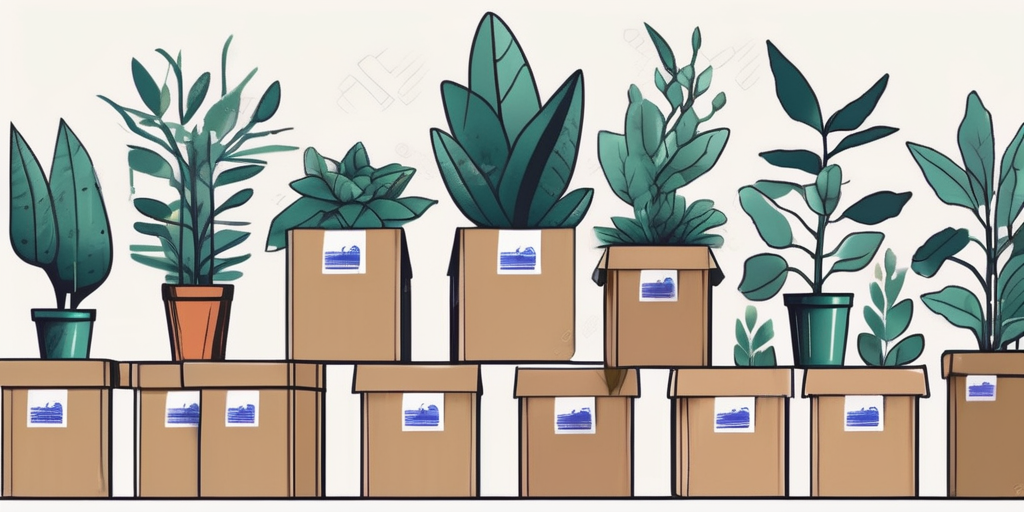Can You Mail Plants With USPS? Fedex? UPS?

If you’ve ever wanted to send plants through the mail, you may be wondering if it’s possible to use popular shipping services like USPS, FedEx, or UPS. In this article, we will explore the basics of mailing plants and the specific policies and guidelines of each service to help you make an informed decision.
Understanding the Basics of Mailing Plants
Mailing plants can be a convenient way to share a piece of nature with loved ones or transport your green treasures to a new location. Whether you’re an avid gardener or simply want to surprise someone with a special gift, understanding the process and regulations is crucial.
Legal Considerations for Mailing Plants
Before diving into the specifics of each shipping service, it’s important to be aware of the legal considerations when mailing plants. Different states and countries have their own regulations and restrictions on importing or exporting plants due to potential risks of spreading pests or diseases. It’s crucial to check the guidelines and requirements of both the destination and origin before shipping plants.
When it comes to mailing plants, it’s not just about the convenience and joy it brings. It’s also about adhering to the laws and regulations put in place to protect our ecosystems. By understanding and following these legal considerations, you can ensure that you’re not inadvertently contributing to the spread of invasive species or plant diseases. For example, the shipping of plants via USPS must adhere to the US Code Title 7 U.S.C as well as Title 39, which deals with the Post Office.
Some countries have strict quarantine measures in place to prevent the introduction of pests and diseases that could harm their agriculture or natural habitats. These measures may include inspections, permits, and certifications. It’s essential to research and comply with these requirements to avoid any legal issues or potential harm to the environment.
Furthermore, it’s important to note that some plants are protected by international agreements, such as the Convention on International Trade in Endangered Species of Wild Fauna and Flora (CITES). These agreements aim to regulate the trade of endangered plants and ensure their survival in the wild. If you’re considering mailing a rare or exotic plant, make sure to check if it is covered by any international agreements and obtain the necessary permits if required.
Mailing Plants with USPS
As one of the most widely used shipping services in the United States, USPS offers options for shipping plants to various destinations.
When it comes to mailing plants, it’s important to understand the policies and guidelines set by USPS. While USPS does allow the mailing of live plants, there are certain conditions that need to be met. It’s crucial to note that not all plants are eligible for shipment due to their exotic or invasive nature. To ensure a smooth mailing process, it’s advisable to check USPS regulations and contact your local post office for guidance before attempting to mail plants.
Now, let’s delve deeper into the policies set by USPS. The reason behind these regulations is to protect the environment and prevent the spread of invasive species. USPS takes its responsibility seriously and aims to maintain the ecological balance by restricting the shipment of certain plants.
When it comes to packaging, it plays a crucial role in ensuring the safe delivery of your plants through USPS. Proper packaging not only protects the plants but also helps in maintaining their freshness and health during transit. So, what are some packaging tips to consider?
First and foremost, it’s essential to use sturdy boxes that can withstand the rigors of shipping. Opt for boxes made of durable materials that can provide adequate protection to your plants. Reinforce the corners and edges of the box to prevent any potential damage.
Next, securely fasten the plants within the box. This can be done by using plant ties or wrapping the plants gently with soft materials like newspaper or bubble wrap. The goal is to keep the plants in place and prevent them from shifting during transit.
Adding appropriate padding is another crucial step in the packaging process. Use materials like packing peanuts, shredded paper, or even air-filled plastic cushions to create a cushioning layer around the plants. This extra layer of protection will absorb any shocks or impacts that may occur during transportation.
Don’t forget to label the package as “live plants.” This simple step can make a big difference in how your package is handled. By clearly indicating the nature of the contents, USPS personnel will be aware of the need for careful handling and provide the necessary care to your plants.
Remember, the success of mailing plants with USPS depends on adhering to their policies and ensuring proper packaging. By following these guidelines, you can increase the chances of your plants arriving safely and in good condition at their destination.
Sending Plants via FedEx
FedEx is another popular option for mailing plants, offering reliable service for both domestic and international shipments.
FedEx’s Stance on Plant Shipment
FedEx does allow customers to ship plants, but it’s important to familiarize yourself with their specific guidelines and restrictions. It’s advisable to contact FedEx or visit their website to review the most up-to-date information before sending plants via this service.
When it comes to shipping plants, FedEx understands the importance of ensuring their safe transportation. They have implemented various measures to ensure that plants are handled with care and delivered in optimal condition. By following their guidelines, you can have peace of mind knowing that your plants will be well taken care of throughout the shipping process.
One of the reasons why FedEx is a popular choice for shipping plants is their extensive network. With numerous distribution centers and delivery routes, FedEx can reach even the most remote locations, making it convenient for both senders and recipients.
Furthermore, FedEx offers both domestic and international shipping options, allowing you to send plants to loved ones across the globe. Whether you want to surprise a friend with a beautiful potted plant or send rare botanical specimens to a collector in another country, FedEx has you covered.
How to Package Plants for FedEx
Proper packaging of plants is crucial to ensure their safety during transportation with FedEx. Secure the plants in sturdy containers, using appropriate cushioning materials to protect them from being jostled. Labeling the package as “live plants” will help ensure that they receive the necessary care en route.
When packaging plants for FedEx, it’s important to consider the specific needs of the plants you are shipping. Some plants may require additional protection, such as wrapping delicate leaves in tissue paper or using specialized containers for plants with long stems.
Additionally, it’s essential to provide adequate ventilation for the plants to prevent them from suffocating during transit. This can be achieved by creating small air holes in the packaging or using breathable materials.
Another important aspect to consider when packaging plants for FedEx is the weather conditions. Extreme temperatures can have a detrimental effect on plants, so it’s crucial to take precautions. During hot weather, include ice packs or coolants to maintain a suitable temperature inside the package. In colder climates, consider using insulation materials to protect the plants from freezing.
By following these packaging guidelines, you can ensure that your plants have the best chance of arriving at their destination in excellent condition. FedEx’s commitment to quality service, combined with your attention to detail, will result in a successful plant shipment experience.
Using UPS for Plant Delivery
UPS also offers options for mailing plants, allowing you to safely transport your beloved green friends.
UPS Guidelines for Mailing Plants
UPS has specific guidelines and regulations when it comes to shipping plants. It’s important to review their policies and restrictions before using their services to ensure compliance and the safe delivery of your plants.
Preparing Plants for UPS Shipment
When sending plants via UPS, proper packaging is vital to prevent damage during transit. Use sturdy boxes and secure the plants to prevent them from shifting. Including appropriate padding and labeling the package as “live plants” will help ensure that they receive the necessary care during shipping.
Comparing USPS, FedEx, and UPS for Plant Shipment
Each shipping service has its advantages and considerations when it comes to mailing plants. By comparing USPS, FedEx, and UPS, you can determine which service best suits your needs.
Cost Comparison for Mailing Plants
While the cost of mailing plants may vary depending on factors such as size, weight, and destination, comparing the pricing structures of USPS, FedEx, and UPS can help you make an informed decision. Consideration of additional insurance or tracking options may also play a role in the overall cost.
Speed and Reliability of Each Service
The speed and reliability of each shipping service are important factors to consider when mailing plants. Understanding the estimated delivery times and service reliability can help ensure that your plants arrive in optimal condition and within the desired timeframe.In conclusion, it is possible to mail plants using services like USPS, FedEx, and UPS. However, it’s crucial to familiarize yourself with each service’s policies and guidelines to ensure compliance and the safe delivery of your precious plants. By following the proper packaging procedures and considering factors such as cost, speed, and reliability, you can choose the best shipping service for your plant shipment needs.
